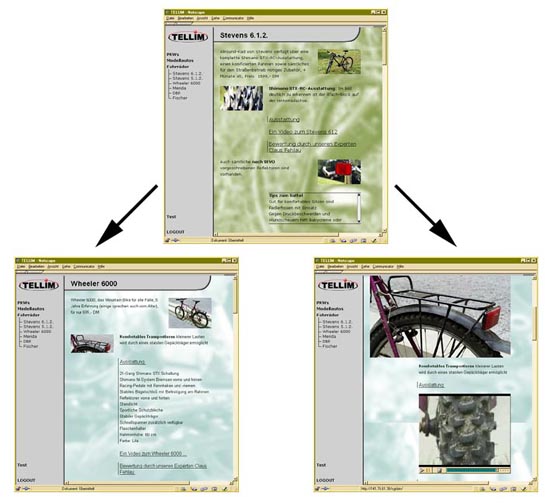







The motivation for developing the TELLIM system is mainly based on two observations. Firstly, multimedia elements are very suitable for product marketing on the WWW. Images, music and videos not only inform the customer about some details, they also convey an atmosphere. Customers get information via more than one senses. Instead of reading only the characteristics of a product, they get a realistic impression. Therefore the effect of the presentations and the advertisement is much higher.
But secondly the preconditions of the customers are quite different. Some of them like multimedia elements very much. Other customers call large images and video unnecessary. Customers' connections to the Internet differ in quality, they have different processor types, memory size, some have multimedia capabilities, like graphic card, sound card, microphone, etc. They also use a variety of presenta-tion platforms like PCs, Laptops, Personal Digital Assistants (PDA) or Handhelds.
Because of such varied preconditions there are very different possibilities of using multimedia presentation in the WWW. This also means that static product pres-entations on the WWW cannot always meet the expectations of all customers.
Considering the above mentioned aspects, the aim of the TELLIM (inTELLIgent Multimedia) system is the adaptation of product presentations to the individual customer, so that every customer gets a presentation that appeals to him and that meets his actual interests. Figure 1 shows in the center image how a bike is presented in the beginning of a session.

In this example, the presentation consists of small images, texts and a link to a video. Depending on the customer's behavior the next presentation is generated. If the customer has e.g. chosen the text in the first presentation and has not enlarged the images or chosen the video, the next presentation would be generated like in the left image where the text is uncol-lapsed and the images are integrated in small size. If the customer has ignored the textual links but enjoyed the video and enlarged the image, the presentation of the next bike would be like in the right image of Figure 1 where the images can be seen in large size and the video is already integrated in the appropriate player.
Depending on the user behaviour, the next presentation is generated. If the user e.g. has chosen the text in the first presentation and has not enlarged the image or played the video, the next presentation would be generated like in the left image. If the customer has not choosen the textual links, but start the video and enlarged the image, the presentation of the next bike would be like in the right image of Figure 1.
This means that every piece of information concerning the product is visible for the customer, but preferred elements are presented in the foreground and uninteresting elements of the product description are presented only as links in the background. Additonally to the described adaptation of multimedia elements, the system realizes three other kinds of adaptation: